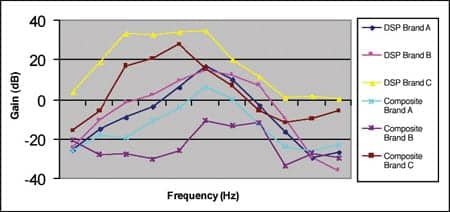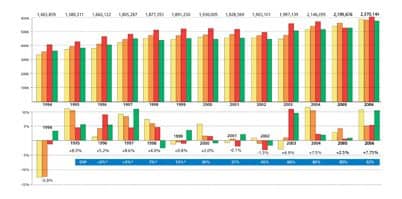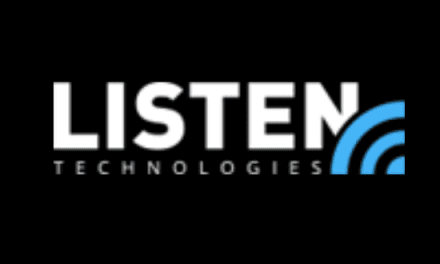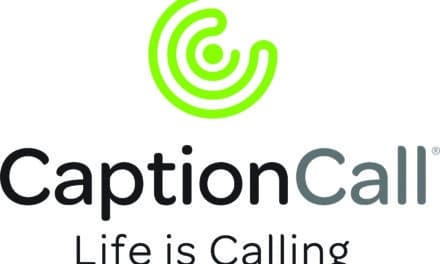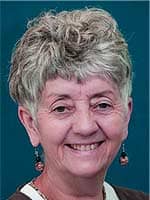It started simply enough, with a letter last November from Dan Patzlaff, BC-HIS, of Green Bay, Wis, who wrote in with several helpful suggestions, the last of which was: “One thing I think needs to be addressed in this industry is assistive listening devices. The margins are horrible and that is why it is a neglected sideline industry.”
After letting that percolate for a bit, I decided to do just that and address that very topic by engaging representatives from a variety of ALD suppliers and manufacturers in the following Q&A.
HPR Provide a brief overview of your company.
Vanessa Adams, General Manager, Weitbrecht Communications Inc, Santa Monica, Calif: Weitbrecht Communications Inc (WCI) is one of the nation’s largest suppliers of assistive listening devices and has been in business for more than 20 years. The company was originally founded by Dr Robert Weitbrecht, the inventor of the first text telecommunication devices for people who are deaf or hard of hearing.

|
| Pauline Marrow Davies |
Pauline Marrow Davies, Owner, Hearing For Tomorrow Inc, Duluth, Minn: Hearing For Tomorrow (HFT) specializes in manufacturing and distributing telephone adaptors for people who wear hearing aids. Our products are patented in the United States and Canada. All products are made in Lino Lakes, Minn. This is definitely a “Made in the USA”company. We have been in business since 2002.
Lori Foss, Marketing Director, Harris Communications Inc, Eden Prairie, Minn: Harris Communications Inc was established as a mail order catalog company in 1982 by Dr Robert Harris. Dr Harris is a member of the deaf community and began as a local distributor of assistive devices for the deaf in the Minneapolis/St Paul area. Since that time, the customer base has expanded to the national and international level. As the customer base has grown, so have the variety and types of products sold. More than 1,500 products are available, including a full line of assistive products for hard of hearing people. Harris Communications distributes a variety of assistive listening devices from major manufacturers with products including amplified telephones, personal amplifiers, and infrared systems.
Ragnar Åhgren, CEO, Comfort Audio, Halmstad, Sweden: Comfort Audio AB was established by August Pansell and Carljohan Lagervall in 1994. Our focus on quality and technology innovation since our start has earned Comfort Audio an international reputation for leadership in the field of assistive listening devices. In addition to personal ALDs, we offer a range of hearing systems to enable active work environments and systems to promote learning in schools.
Becky Morris, President, Beyond Hearing Aids Inc, Erlanger, Ky: Beyond Hearing Aids provides training, support, and sales of assistive listening and alerting devices to professionals who serve people with hearing loss. We also provide direct service to professional referrals. We’ve been in business 15 years.
HPR What are the most popular ALD products your company offers?
Adams, WCI: The CapTel captioned telephone that shows word-for-word captions of everything that your caller says during a phone conversation. CapTel is ideal for hearing aid wearers, as the captions give people extra confidence over the phone in case they miss a word here or there.
Davies, Hearing For Tomorrow: The most popular item is the Tel Ear II, a patented design that was reconfigured with Velcro rings to accommodate the many designs of telephone handsets on the market. The Cell-U-Hear Listening Pad for cell phones is the second most popular.
Foss, Harris Communications: Amplified telephones, personal amplifiers, and TV listening devices.

|
| Ragnar Åhgren |
Åhgren, Comfort Audio: Comfort Audio only markets ALDs in the United States and currently we have two products available. At the low end, we have the Comfort Duett personal amplifier that has a built-in T-coil. It is very lightweight, less than 2 ounces, and offers superior sound, with amplification of up to 60 dB. Comfort Contego is a high-definition, digital wireless FM assistive listening system. The small units have a distinctive look and feel with easy to read digital screens. The volume setting for the transmitter can be remotely adjusted from the receiver. The Comfort Contego sends its signals encrypted to prevent electronic eavesdropping, an industry first. It can be used with or without hearing aids, and the signal carries some 75 feet.
Morris, Beyond Hearing Aids: The most popular ALDs we sell are cordless telephones, alarm clocks, cell phone accessories, and amplified stethoscopes.
HPR How would you explain the perception of ALDs as a negative sideline industry?
Adams, WCI: When people are being fitted for expensive hearing aids, they naturally expect that the hearing aid will solve all of their hearing problems. It is difficult for an audiologist to say to their patients, “This hearing aid is going to work great for you, but you still might not be able to hear well on the phone. Or you still may have difficulty hearing in crowded environments.” The fact is, for some people the ideal solution is pairing hearing aids with ALDs, for an extra boost on the telephone or some extra help discriminating sounds in a crowded room. But asking a patient to spend thousands of dollars on a hearing aid and then recommending an additional device for special situations is a really hard sell.
Davies, Hearing For Tomorrow: After having worked in the hearing industry as a magazine publisher for many years, it is my opinion that ALDs have the ability to make or break a hearing impaired person’s success in adapting to using a hearing instrument. While not every office wants to get involved with ALDs and they are considered somewhat bothersome, ALDs are a necessary item.
Foss, Harris Communications: Although I have never heard them described that way, it is probably because the profit margins are lower than with selling hearing aids.
Åhgren, Comfort Audio: We see evidence that younger, newer audiologists are more open to ALDs than perhaps some of those who have been in business longer. It is quite possible that any negative perceptions stem from what at one time were fairly mediocre products perhaps better suited for sales staff at a Radio Shack, not for an extensively trained medical expert specializing in small sophisticated technologies. We should also keep in mind that the hearing health care industry is more than audiologists in private practice. There are a great number of industry professionals working for state or federal agencies that have the power and ability to recommend solutions. To them, rather than a “margin issue,” they have a budget issue, and often find an ALD can do a fine job for several years. However, as the patienst come first, and many of them were not happy with early FM systems, they therefore often would end up recommending hearing aids.

|
| Becky Morris |
Morris, Beyond Hearing Aids: One reason could be the negative experience many audiologists have encountered when selling an ALD. Clients expect the audiologist to fix the ALD the same way they do the hearing aid. Clients are encouraged to come in to the office for follow-up and care for their hearing aids. But if an ALD has a problem after 30 days, the product must be serviced directly under the manufacturer’s warranty. This inconsistency puts the audiologist in a difficult position if they don’t explain it clearly.
HPR Is there any validity to the claim that the profit margins are too low?
Åhgren, Comfort Audio: I think margins are not really the issue, but the size of the sale. At the same margin, obviously a product at $200 will net a smaller profit, than a product sold for $2,000 or even $4,000. The profit margins are a function of how a reseller buys. Manufacturers cannot feasibly sell one item at a time to a reseller. Such a reseller has to go through distributors, which, of course, eats into the net margin. A clinic that deals in high volume—hearing aids or ALDs—is likely able to buy in volume, keeping more of the profits in the end. And there are other ways of looking at profitability than margin. Return on Time. One of the reasons hearing aids can be rather expensive is the high level of service and often many hours that the dispenser puts into the sale. An ALD, on the other hand, requires far less adjustment and explanation. Often it is as simple as “Does this make the patient hear better?” and “Come back when it is time to look at the hearing aid again.” We have satisfied clinics where dispensers have cut back on waiting time and backlog, by making sure patients with only minor hearing problems are served quickly with today’s ALDs.
Morris, Beyond Hearing Aids: If you compare ALDs to hearing aids as a profit center, then profit margins are low. If you look at ALDs as an intrinsic component to the overall goal of better hearing, then their value increases. For example, an alarm clock sale for the sake of the sale means little toward profit. But if you solve a need that the hearing aid can’t, then you have clearly added benefit and value by working with you. If you are going to sell ALDs, expense them as cost of goods sold or advertising instead of a profit line item.
HPR What are some of the objections you hear from audiologists as to why they don’t more readily accept and offer ALDs to their patients, and what does your company do to counter such objections?
Adams, WCI: By comparison to traditional hearing aids, the profit margin on ALDs is considered very low. In addition, audiologists are concerned that ALDs require too much time with each patient, determining what their needs are and then helping them learn how to use the devices. That is why we recommend that audiologists partner with an established ALD provider, who will stay abreast of all the changing ALD technologies and can take the time to educate patients on the proper use of the equipment. It costs an audiologist nothing to include ALD catalogs in their office waiting room.
Davies, Hearing For Tomorrow: While the profit margins are considered low in comparison to the profit margins of a hearing instrument, ALDs also do not require the technical knowledge. While the return for credit rates for hearing instruments have improved significantly during the past few years—which is a very good thing—I have often wondered just how many of those new hearing instrument wearers return to their home after the final fitting, pick up the telephone, and call a loved one who encouraged the process. Only to experience squealing and feedback. Frustrated, the hearing instrument is returned. And the negative experience is repeated over and over to friends.
Foss, Harris Communications: I think the main objection is that they don’t have the time to show ALDs to their patients. Besides the time involved with showing the product, there is the time involved with learning about the product and the added expense of keeping products on hand. Many audiologists refer patients to an ALD distributor for that reason.
We are happy to take an audiologist referral, but there are some benefits to having a patient try out a product in the doctor’s office. One benefit is that with hands-on usage the patient learns how valuable an ALD can be. Another benefit is that audiologists can point patients to quality ALDs. There are a lot of cheaper ALDs being advertised in the mainstream market that have poor sound quality. As the hearing expert, the audiologist can make sure the patient isn’t spending dollars on products that won’t work for them.
Selling ALDs is not as hard as it may look. Developing a relationship with an ALD distributor will give insight into the best products to have available to show patients. The ALD distributor often is able to dropship products to the customer so the product doesn’t need to be stocked in the office. Although ALDs may have lower profit margins, they can help the audiologist’s bottom line. From a marketing standpoint, a doctor discussing ALDs is looking at the patient’s total hearing needs. For those patients who are initially resistant to hearing aids, an ALD may be one way to develop an ongoing relationship that can mean future business and future referrals.
On a related note, we often have people come into our company showroom who have been to an audiologist but were not told about ALDs. Many times there is a sense of relief finding out that these products are available, but some customers wonder why they were not told about ALDs by their audiologist.
Åhgren, Comfort Audio: I think it is simply a matter that audiologists are trained to dispense hearing aids. Period. It is not that they are against ALDs; it is just not their job, as they see it. We are pleased to note that schools now add ALDs to their curriculum. In the objectivity of an academic setting, they learn, among other things, the pros and cons of each solution, and will bring those insights when they start treating patients. Within the context of the discussion about the state of health care in America today, it all has to start with patient needs and what solution—and costs—is right for each patient.
Clearly, health care cost has become a huge issue in America today, and is certain to grow worse with an aging population. Those costs make up some 16% of the US GDP, while in Europe it is more like 8% without any noticeable negative health outcomes—on the contrary actually. Many factors contribute to this, but the use of expensive technologies here is one major factor. Just because a medical clinic can afford to lease an MRI machine, does not mean that every patient who comes in the door needs a scan. But many do, at times unnecessary, adding to the cost. So, making sure patients get what they need, and not more, is certainly one message.
Another is to think more like a businessperson, not just as a medical professional. We talked about “return on time.” Other retailers manage products they sell by the use of “return of square footage.” There are “unused” spaces in any clinic, especially in the waiting area. A brochure holder takes up only square inches. Demonstration ALDs, tethered on a wire, like in a phone store, not much more. Nonlicensed staff can explain and answer questions. And in most cases, an ALD sale is incremental, not a substitute for a hearing aid sale.
An ALD equipped with a T-coil obviously is purchased because it enhances the versatility of a hearing aid. And in those cases when a person, after having tested hearing aids, for whatever reason, ideally in consultation with a trained professional, decides to forego the hearing aid in favor of an ALD, it is most often a postponement of the hearing aid purchase. We see ALDs as marketing tools for audiologists. We talked about increasing return on footage. You also use them to build trust and establish a loyal patient base. If an expert says an ALD will suffice for now, that patient, when experiencing further loss, is more likely to return to the same trusted expert, than to the one who only tried, but did not make a hearing aid sale.
Or take it even further: a small affordable personal amplifier, purchased at wholesale cost by an audiologist and given away free to patients not yet ready for hearing aids, is a deductible business expense and is certain to bring that person back later. With more than 70 million Baby Boomers raised on rock and roll, Walkmans, and iPods, and marketed to with cool products for half a century, now nearing retirement and poor hearing, the audiology business should no longer be focused on just the very old and very hard of hearing. I do believe that most audiologists know what hard of hearing associations and other institutions often repeat: “Only some 20% of those with needs are currently served by the industry.” With the right focus, the dispensing industry is a huge growth opportunity!
Morris, Beyond Hearing Aids: Reasons include: I don’t have the time. I’m not knowledgeable enough about ALDs. I’m not really sure that ALDs provide that much benefit to be worth the trouble. Returns are costly and time-consuming. Clients expect me to fix their product like I do their hearing aid.
Beyond Hearing Aids understands many of the reasons are valid. Trying to stay abreast of the technology advances with hearing aids leaves little time to learn another set of technology that also changes rapidly. We don’t necessarily counter the objections. Instead, we offer direct services to the clients of providers who are referred to our office. We provide the professional service that extends from the audiologist’s office. This meets the needs of many audiologists and counters the objections.
HPR Has your company been successful in expanding its presence in the marketplace?
Adams, WCI: There are definitely audiologists who are making the effort to include ALDs as part of their comprehensive care, but they are still in the minority. WCI has also been very successful marketing to consumers directly. But it is clear that consumers would benefit tremendously by learning the advantages of ALDs from their audiologist first, instead of seeking out solutions on their own.
Davies, Hearing For Tomorrow: We are now offering all of our products on “clip strips,” which are used by retailers the world over. They require no stocking on shelves, and are ready to hang up. Also, our products are bar coded to facilitate inventory management.
Foss, Harris Communications: We have been in business more than 25 years and are one of the largest distributors of ALDs in the United States. We have been successful expanding our business through our catalog and our Web presence. Our product catalog is a good reference for the ALDs available in the marketplace and is well known in the industry. We also have a presence through various state programs, caregiver associations, vocational rehabilitation programs, as well as the Veterans Administration. Of course, we are very appreciative of the many audiologists who either purchase from us or direct patients to us.
Åhgren, Comfort Audio: We are new to the United States since 2006, and are pleased with our success so far. We attribute that to our products that are more sophisticated with more appealing designs than what existed before. We definitely have seen an increased interest in our sophisticated Comfort Contego. We sell more of them now packaged with a neckloop, than with earbuds, as professionals are learning about it. And reading and hearing about it and us is a function of us actively spreading the word and promoting our products in ads, on the Internet, and at trade shows. Next up in April is the annual AudiologyNow! in Charlotte, NC. That means having to reach professionals in the trade magazines and shows, and also consumers via the media and events. Nothing pleases us more than hearing from an audiologist who has discovered our products from one of their patients. And testing and using the products is often the key to discovery and acceptance, so some of our distributors actively promote our products toward audiologists.
Morris, Beyond Hearing Aids: We have been successful in expanding our presence. Audiologists who want to do the right thing but don’t have the time or resources can still provide professional direct services for ALDs by referring them to us for follow-up care. Our company services appeal to them.
HPR Do you think that the perception of ALDs has developed positively or negatively within the hearing health care industry, and if so, why or why not?
Foss, Harris Communications: We receive many calls from audiologists asking for assistance for a particular patient. I think there is more realization that ALDs will play a part in assisting a patient.
As for negative perceptions, there are a lot of ALDs coming on the market that are trying to reach the Baby Boomer market. Those of poor quality can create a negative perception of ALDs, especially if they suggest that if you have an ALD, there is no need for a hearing aid. Most professional ALD distributors will question customers about whether they wear a hearing aid or have seen an audiologist about their hearing loss.
Åhgren, Comfort Audio: As said above, schools now cover ALDs, younger audiologists have a different view, and better products are increasingly being discovered and accepted by the industry. And, if nothing else, as the Boomer generation has driven various markets, they too will change how the hearing health care industry changes in the future. We have already seen that audiologists who focus on patient needs are successfully building their businesses with hearing aids and ALDs that co-exist.
Morris, Beyond Hearing Aids: While we try to provide services that take away the objections to ALDs, I believe it is the professional’s obligation to inform their clients about ALDs, regardless of the cost or comfort level. You don’t have to be the expert or the person to provide the service. But I do believe you have to be the first point of contact. Providing reputable resources is a professional way to support ALDs positively.
Will Campbell is editor of Hearing Products Report. He can be contacted at [email protected].

